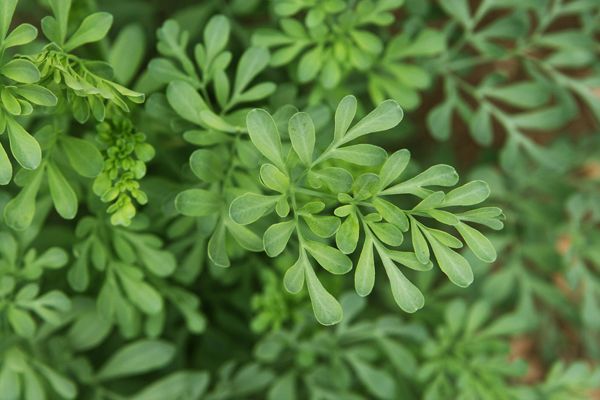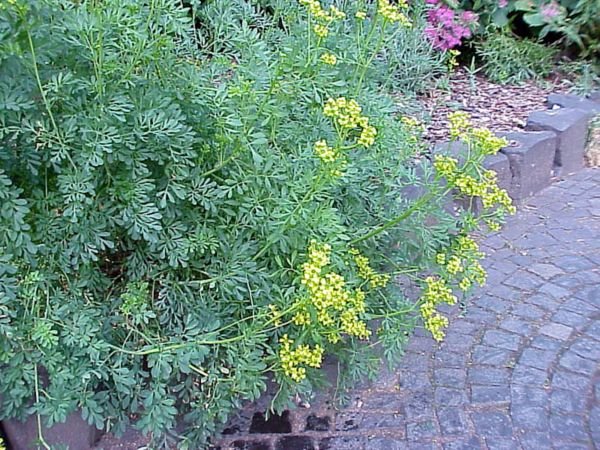
Rue was one of the herbs planted in the first herb garden on the south side in 1992. It did really well there. For some reason I have no photos of it, just where it should be but you can’t see it. It was a pretty and robust plant early on so not sure why there are no photos.
I had noticed when I weeded that south garden a day or so later I would have dark brown splotches on my hands for a while. It took a few years to figure out what I was reacting to: the rue.
Sometime between 1999 and 2003 it was winter killed. It had been having a hard time with winter kill for a few years but always managed to come back. But this time it didn’t and I didn’t replace it due to the skin irritation.

Ruta graveolens L. aka garden rue, common rue, German rue, herb of grace, countryman’s treacle, is a hardy, evergreen perennial shrub from which you can use the leaves. It grows 2’ – 3’ high and can be found in pastures, roadsides, and abandoned lots. Zones 4 – 9.

Flowers: bright yellow flower ½” across with green centers and extra long stamens in loose clusters. Flower is frilled and slipper-shaped. Flowers June – July.

Leaves: aromatic blue/green, alternate, pinnately divided leaves. Small, rounded, lobed, smooth, and dotted with oil glands.
Cultivation: full sun but tolerates light shade. Prefers well drained alkaline soil with poor – moderate fertility for the hardiest plants. Divide it in the spring and take plant cuttings in late summer. Seed can be sown in spring but is slow to germinate. Pruning should be done in late spring. Plant 1½’ apart. Protect in winter and mulch in winter. Will grow indoors.
Medicinal: WARNING: May cause mild poisoning. Wet foliage is an irritant. Sap from stems causes rashes.
Leaves can be used in teas under strict medical supervision for appetizer, bile stimulant, menses stimulant, in compresses for wounds and ulcers. Also as a tonic for iron and minerals salts. It is an anti-spasmodic and destroys intestinal worms. Also: hysteria, blood pressure, arthritis, rheumatism, neuralgia and a cough suppressant.
I never used it for anything, especially once I found I reacted to it.
Culinary: it was used for flavoring in the past. It is pungent and intensely bitter.

References:
Taylor’s Perennials page 99
Right Plant, Right Place page 160
Credits:
Flowers @Plenuska Creative Commons Attribution-Share Alike 4.0 International
Plant @Quinn Dombrowski Creative Commons BY-SA
Plant on sidewalk Permission granted to use under GFDL by Kurt Stueber Source: [http://www.biolib.de www.biolib.de
Plant on dirt @Plenuska Creative Commons Attribution-Share Alike 4.0 International
Rue illustration Permission granted to use under GFDL by Kurt Stueber Source: www.biolib.de
WARNING - The message you received from @masjuan is a CONFIRMED SCAM!
DO NOT FOLLOW any instruction and DO NOT CLICK on any link in the comment!
For more information, read this post: https://steemit.com/steemit/@arcange/phishing-site-reported-upperwhale
Please consider to upvote this warning if you find my work to protect you and the platform valuable. Your support is welcome!
Downvoting a post can decrease pending rewards and make it less visible. Common reasons:
Submit
Bitters are so good for you.
Downvoting a post can decrease pending rewards and make it less visible. Common reasons:
Submit